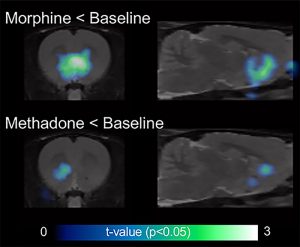
A figure from this study
Hot Off the Press – April 1, 2019.
Identifying non-addictive opioid medications is a high priority in medical sciences, but μ-opioid receptors mediate both the analgesic and addictive effects of opioids. We found a significant pharmacodynamic difference between morphine and methadone that is determined entirely by heteromerization of μ-opioid receptors with galanin Gal1 receptors, rendering a profound decrease in the potency of methadone. This was explained by methadone’s weaker proficiency to activate the dopaminergic system as compared to morphine and predicted a dissociation of therapeutic versus euphoric effects of methadone, which was corroborated by a significantly lower incidence of self-report of “high” in methadone-maintained patients. These results suggest that μ-opioid-Gal1 receptor heteromers mediate the dopaminergic effects of opioids, which may lead to a lower addictive liability of opioids with selective low potency for the μ-opioid-Gal1 receptor heteromer, exemplified by methadone.
Publication Information
Opioid-galanin receptor heteromers mediate the dopaminergic effects of opioids. Journal Article
In: J Clin Invest, vol. 130, 2019, ISSN: 1558-8238 (Electronic); 0021-9738 (Linking).
